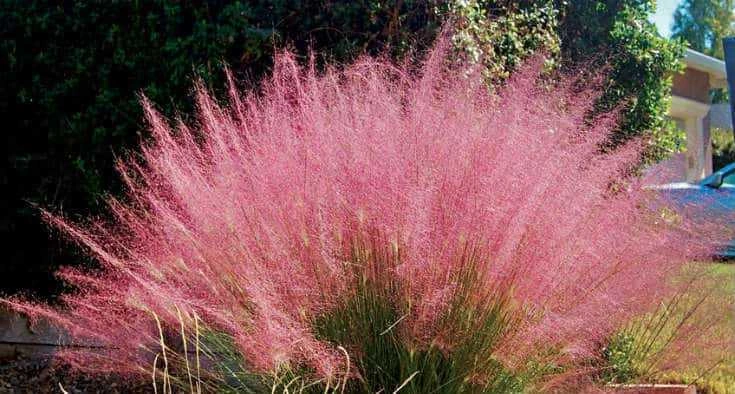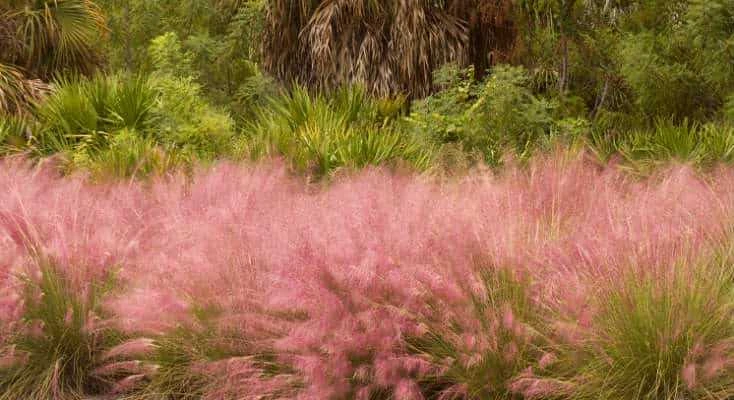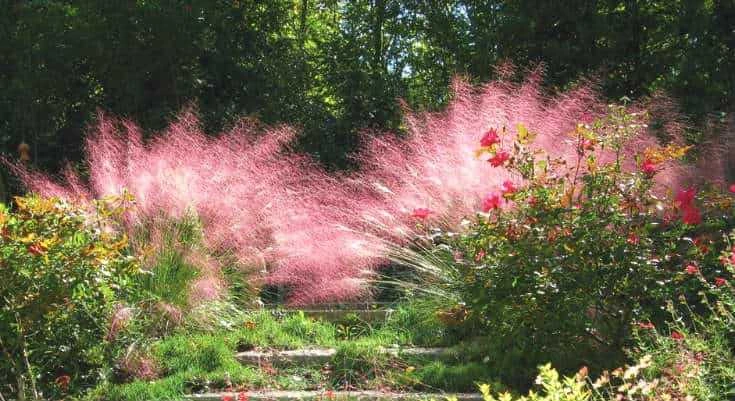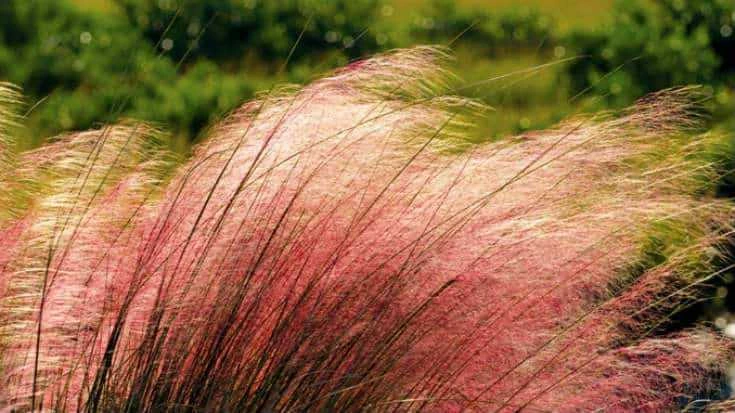When searching for the perfect bloom that brings both color and whimsy to the garden, consider a plume bloom! Muhlenbergia Capillaris, commonly known as Pink Muhly Grass, is an ornamental warm season perennial grass famous for wispy, pink plumes peeking above dense, green foliage, adding an unexpected flair to landscaped beds.
Do not be deceived by its delicate appearance, though. Pink Muhly Grass mounds are quite hardy, requiring little maintenance or extra watering.
They can grow almost anywhere in the U.S., stay green throughout the winter, and bloom each fall.
Let’s look at Pink Muhly Grass and how to incorporate it into the garden.
Pink Muhly Grass is native ornamental grass to the North American Continent, particularly California and the eastern United States. It is a fast-growing plant, reaching a maturation height of four feet in just a couple of seasons, and its thick foliage can reach three feet in width.
Dark green leaves will brighten in the spring, with its notorious pink plumes debuting in late summer or early fall.
Pink Muhly Grass likes plenty of sunshine and thrives in areas that receive partial to full sunlight. It can grow in nearly any type of soil that is well-drained and even drought tolerant.
Every 2 to 3 years, the plants can be divided and shared with other areas of the garden.

When to Plant Pink Muhly Grass?
Pink Muhly Grass is a relatively low maintenance ornamental grass that anyone can maintain. It is best to plant Muhlenbergia Capillaris in the spring. As the seasons progress into summer, the blue-green mound of grassy foliage will begin to take shape and spread out over 2 feet in diameter.
The feathery, pink blooms will make their dramatic debut by early fall just when most other flowers are beginning to fade away.
Where to Plant Muhlenbergia Capillaris?
Pink Muhly Grass thrives in zones 5-9. As far north as New England and as far south as Florida, Pink Muhly can flourish and brighten almost any landscape.
Caring of Pink Muhly Grass
When to Water
Ideally, the plants will receive weekly rainfall, but mature plants do not require extra watering unless they have experienced a particularly dry season.
For baby Pink Muhly Grasses and newly transplanted mounds, give them several good drinks of water for the first few weeks while their roots get established.
Soil
Pink Muhly Grass grows naturally in rocky soil, forests, or on coastal dunes. It is not picky about where it takes root.
For best results, though, make sure that the soil is well-drained and that the grass mound will not have to sit in standing water.
How to Prune Pink Muhly Grass?
Pink Muhly Grass is considered an evergreen, but there may be some grass blades that turn brown over the winter months. Cut these dead blades off in early spring with scissors or small pruning shears.
Other than that, they do not require regular trimming unless the gardener wishes to give them a new shape.
Division
Another appealing aspect of these hardy perennials is that they can be divided once they are mature. Every 2 to 3 years, gently pull up the plant mound and divide the root ball into two pieces.
Be sure to include plenty of green foliage on each half of the divided plant. Transplant the divided pieces into well-drained soil in an area that gets plenty of sunshine.
Give the new transplant several good drinks of water over the first few days, and anytime it experiences a dry spell over the next few weeks.
Planting and Cultivating Young Pink Muhly Plants
It is always a good idea to add fertilizer or compost to the soil before planting. If using a pre-packaged fertilizer, look for one with an NPK (Nitrogen, Phosphorus, Potassium) ratio of 10-10-10.
Spread the fertilizer evenly over the ground and work it into the dirt. Cultivate the fertilized soil 8 to 10 inches deep with a tiller, spade, or garden hoe.
Dig a hole deep enough to cover the root ball and place the young or newly divided muhly grass inside.
Make sure that the plant’s crown – the bottom of the plant where the grass emerges from the roots – is slightly above the rest of the soil. Once the plant is in the hole, fill it with water to give the roots a good drink and jumpstart growth.
Once the root ball has absorbed the water, fill in the hole with soil.
Throughout its first growing season – especially in the first few weeks – water the muhly grass frequently enough to keep the soil moist, but not soggy.
Remember, muhly grasses appreciate water but must have well-drained soil.
At the end of its first growing season, the muhly grass will be mature and well established, so it will not require any extra watering unless it has experienced a particularly dry and hot season.

Where to Buy Pink Muhly Grass
Pink Muhly Grass is not only easy to grow, it’s also easy to find. Local nurseries or the lawn and garden section of many major retailers will have them available in the spring and summer.
They can also be ordered online and delivered to the front door, ready to plant.
Wayside Gardens offers baby Pink Muhly Grass in a 1-quart container for just $14.95, but if purchased in sets or 3 or more, each grass plant is discounted.
The Daylily Nursery also has a wide selection of muhly grass plants on Amazon. A set of three plants in 2.5-quart containers for just $27.55 with free shipping available on certain purchases.

Is Pink Muhly Grass Invasive?
Pink Muhly Grass is not considered invasive in most regions where it is grown. It is a native grass that naturally occurs in parts of the southeastern United States, including Texas, Oklahoma, and Florida. As a native species, it typically does not pose a significant threat to local ecosystems or crowd out other native plants.
However, it’s essential to note that invasive potential can vary depending on the specific location and environmental conditions. In some areas, plants may behave differently due to factors like climate, soil conditions, and local wildlife interactions. Invasive characteristics can also arise when non-native varieties or cultivars of Pink Muhly Grass are introduced to an area where they may not have natural controls to limit their spread.
To ensure you are planting responsibly, it’s essential to verify with local agricultural extension offices or conservation organizations about the status of Pink Muhly Grass in your region. They can provide specific information on whether it is native or invasive and offer guidance on responsible gardening practices to prevent potential issues with invasive species.
In general, when planting any ornamental grasses, it is wise to select native or non-invasive varieties whenever possible and avoid planting species known for aggressive spreading in regions where they are not native.
Muhly Grass Variations for Landscaping
Here are some of our favorite muhly grass varieties that can give any landscaped area a professional look:
- Pampas Grasses
- ‘Gracillimus’ Maiden Grass
- Little Bluestem
- Small Fountain Grass
- Blue Oat Grass
Muhly grasses also feature different colored plumes designed to dazzle.
Pink Muhly Grass Companion Plant
This is a stunning ornamental plant that adds a touch of elegance and grace to any garden display. Its airy pink plumes sway gracefully in the breeze, creating a captivating visual spectacle. To enhance the beauty of this grass and create a harmonious garden, consider pairing it with these delightful companion plants:
- Aromatic Aster (Symphyotrichum oblongifolium): With its vibrant purple blooms, the aromatic aster complements the pink hues of Muhly Grass, creating a delightful color contrast that catches the eye.
- New England Aster (Symphyotrichum novae-angliae): Boasting lovely purple, pink, or white flowers, New England Aster adds a touch of height to the garden, creating a layered and visually interesting landscape.
- Sneezeweed (Helenium autumnale): This cheery, daisy-like flower showcases hues ranging from yellow to orange, adding a burst of warm colors that perfectly complement the pink plumes of Muhly Grass.
- Coneflowers (Echinacea spp.): Coneflowers, with their bold, cone-shaped centers and striking petals, come in various colors, such as purple, pink, and white, making them a versatile choice for a Pink Muhly Grass pairing.
- Petunias (Petunia spp.): Available in a wide array of colors, petunias can be strategically placed around Muhly Grass, providing a continuous show of blossoms throughout the growing season.
- Sunflowers (Helianthus spp.): The sunny disposition of sunflowers brightens up the garden and adds a touch of cheerful yellow to complement the soft pink of Muhly Grass.
- Verbena (Verbena spp.): With its clusters of small, vibrant flowers, verbena adds splashes of purple, pink, or white to the garden, enhancing the overall visual appeal.
- Blue sage (Salvia spp.): This delightful perennial herb displays tall spikes of blue or purple flowers that contrast beautifully with the delicate pink plumes of Muhly Grass.
- Aronia (Aronia spp.): The dark berries and glossy foliage of Aronia provide a unique textural element and create an interesting contrast alongside Muhly Grass.
- Aster Oblongifolius: Another aster variety, this plant produces daisy-like flowers in shades of purple, attracting butterflies and pollinators to the garden.
- Carex Pensylvanica: As a low-growing sedge, Carex Pensylvanica forms a lush ground cover that complements the vertical beauty of Pink Muhly Grass.
- Helianthus Divaricatus: This perennial sunflower thrives in dappled shade and offers a subtle yellow bloom that harmonizes with the surrounding pink grass.
- Liatris aspera: Known as rough blazing star, this plant exhibits tall, purple spikes that stand proudly amidst the Pink Muhly Grass.
- Monarda (Bee Balm): Monarda’s showy flowers in shades of red, pink, or purple add a splash of vivid color and attract beneficial pollinators to the garden.
In selecting companion plants, it’s crucial to consider the climate and growing conditions of your region. Some of the mentioned plants might not be native to the same area as Pink Muhly Grass, so it’s essential to ensure they are suitable for your garden’s environment.
When arranging these companion plants, it is generally recommended to space them 24 to 36 inches apart from the Pink Muhly Grass. This spacing allows each plant ample room to grow, prevents overcrowding, and ensures proper airflow to reduce the risk of fungal infections.
However, always consider the specific growth habits and sizes of the companion plants to achieve an aesthetically pleasing and well-balanced garden landscape. With careful planning and thoughtful selections, you can create a breathtaking garden display that showcases the beauty of Pink Muhly Grass alongside its delightful companions.
Pink Muhly Grass Alternatives
Consider some of these alternatives to the Pink Muhly Grass:
- Ruby Muhly Grass
- Purple Muhly Grass
- White Cloud Muhly Grass
- Deer Grass
Conclusion
A professional-looking landscape does not always require a professional landscaper. Muhly grass varieties are a great way to add contrast and bring an element of whim and interest to a yard or garden. Consider adding muhly grass to the spring planting list and enjoy bright, feathery plumes into the fall!

